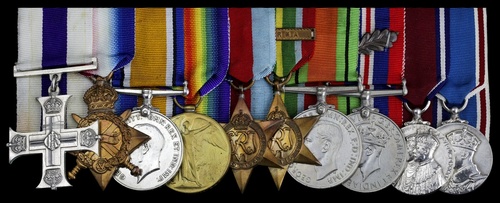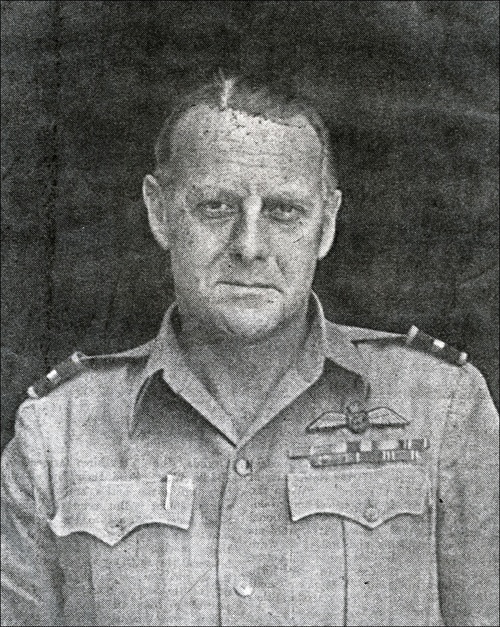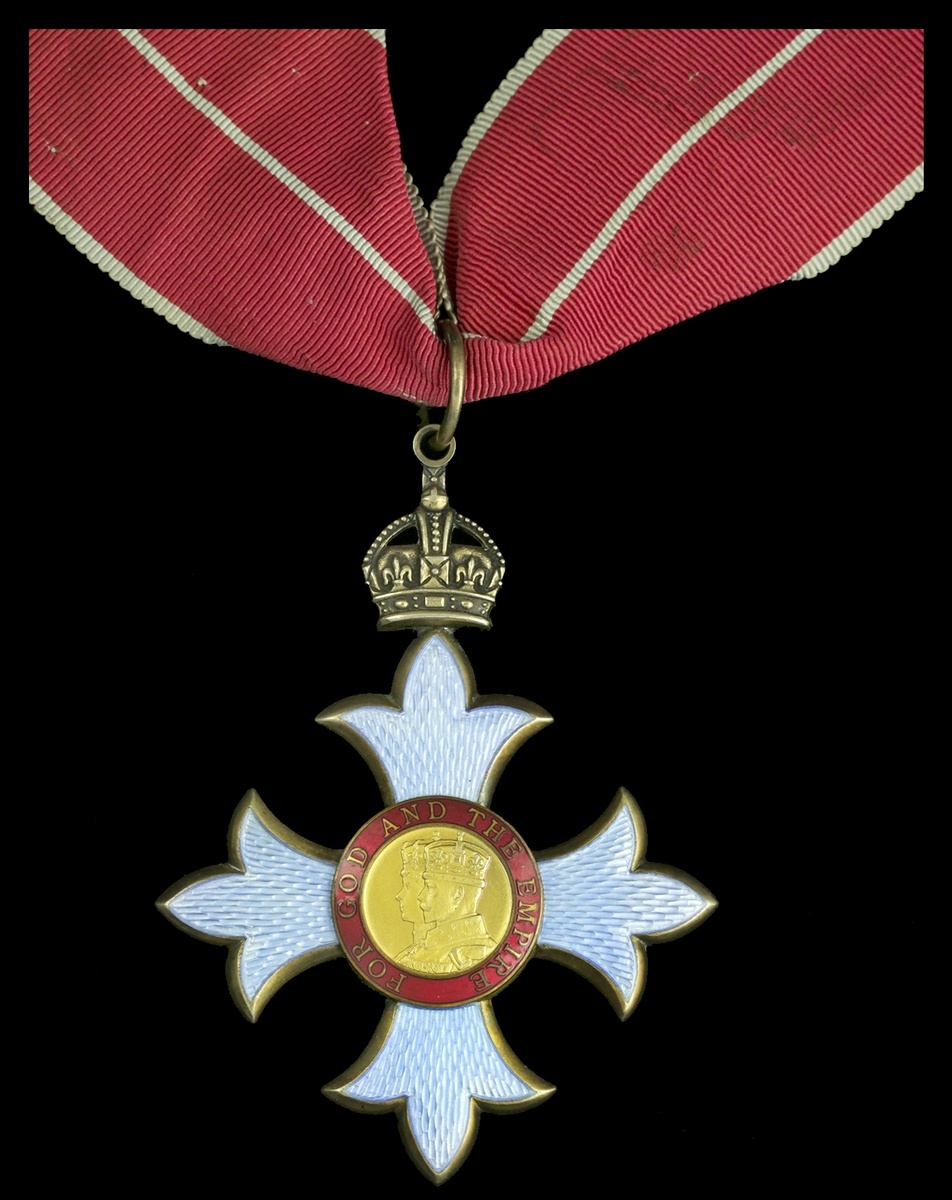Auction: 19001 - Orders, Decorations and Medals
Lot: 580
(x) A particularly fine Second World War C.B.E., Great War pilot’s M.C. group of eleven awarded to Air Commodore H. J. F. Hunter, Royal Air Force, late Rifle Brigade and Royal Flying Corps, who, having been wounded as a young infantry officer in France in 1915, transferred to the R.F.C., won the M.C. for numerous missions flown over the Somme in 1916, commanded No. 9 Squadron in the Ypres salient in 1917 and No. 42 Squadron from the “German Spring Offensive” until the War’s end: very much a C.O. who led from the front, he was however unable to turn the tide of war as A.O.C. (Bombers) in the face of the Japanese invasion of Sumatra in February 1942 - but he did win the C.B.E. for his courage under attack as a Station C.O. in the U.K.
The Most Excellent Order of the British Empire, C.B.E. (Military) Commander’s 2nd type neck badge, silver-gilt and enamel; Military Cross, G.V.R.; 1914-15 Star (Lieut., Rif. Brig.); British War and Victory Medals (Major, R.A.F.); 1939-45 Star; Pacific Star, clasp, Burma; Defence and War Medals 1939-45, M.I.D. oak leaf; Jubilee 1935; Coronation 1937, very fine and better (11)
C.B.E. London Gazette 24 September 1941. The original recommendation states:
‘This officer has commanded an operational station with two heavy bomber squadrons since September 1939, when he took over command of the R.A.F. Station, Driffield. After severe bombing and successive attacks which necessitated the transfer of the two squadrons, he opened up R.A.F. Topcliffe and has continued operations under most difficult conditions. He has shown unfailing loyalty, keenness and devotion to duty and does not spare himself in directing, guiding and encouraging his crews. The fact that the station and squadrons are full of fight is due a great deal to the example of steady courage and calm control of Group Captain Hunter during bombing attacks, one of which was more severe than on any other station in England.’
M.C. London Gazette 20 October 1916:
'For conspicuous gallantry and skill. He has done fine work for the artillery and has accounted for many enemy guns. On one occasion, when a heavy storm drove all other machines back to their aerodromes and the enemy guns took the opportunity to become active, he remained up and did fine work.’
Henry John Francis Hunter was born in December 1893, the son of Henry Charles Vicars Hunter, J.P., the principal landowner in Kilburn, Derbyshire, and the Honourable Florence Edith Louise, daughter of the 12th Baron Dormer of Wyng. He was brought up at Abermarlais Park, Llangadog, Carmarthenshire and was educated at Eton and the R.M.C. Sandhurst.
Commissioned in the Rifle Brigade as a 2nd Lieutenant in February 1913, he was wounded in the legs by a bomb explosion near Poperinghe in September 1915, while serving in the 1st Battalion, at which point, following his recovery, he successfully applied for pilot training in the Royal Flying Corps.
Awarded his “Wings” after attending courses at Reading and Castle Bromwich in May 1916, he flew out to France with No. 34 Squadron, the unit’s B.E. 2e aircraft causing much mirth on arrival at St. Omer, on account of ‘the number of suitcases and odd parcels tied to the under-carriage struts and also alongside the fuselages’ (his extensive Staff College ‘service experiences’ submission refers).
A day or two later, No. 34 arrived at Lilbourne, and quickly commenced work as an artillery co-operation unit over the Somme, a period later described by Hunter in his Staff College submission, from which the following extracts have been taken:
On 'Archie':
‘I well remember one morning I was on the line at dawn and found some lorries behind the village of Martinpoich. Very pleased with myself I was going down to drop my four 25lb. bombs, which were carried on all trips, when “Archie” with his first round broke most of my top plane extension and cut the aileron controls.’
On machine-gun and rifle fire:
‘I was very impressed with the German M.G. and rifle fire. It seemed to be very well organised. Ammunition was rarely wasted if one was over 2,000 feet, but the moment one came down below that height, one was kept under continuous fire. M.Gs seemed to be organised in batteries behind the lines and between them and the rifles our expenditure in wings and tail planes was very heavy.’
In January 1917, the Squadron moved to Villers Bretonneux and worked on the front from Peronne southwards, this time in R.E. 8s. Here, Hunter recalled:
‘We soon had our first experience of looking for the enemy’s troops in more or less open warfare. It did not take us long to discover the difficulties of locating troops in small numbers and of determining the general position of the enemy’s front line. The method generally resorted to was to fly low and get fired at with rifles from a number of points, and then drop the information to our advanced cavalry and forward headquarters.’
In May 1917, Hunter was appointed to the command of No. 9 Squadron, in which capacity he participated in the Passchendaele offensive in support of XIV Corps. He continues:
‘Casualties were heavy in the Squadron, 135 officers going through in four months. Two aircraft were destroyed by direct hits from A.A. on the first day we were on the sector. However, in spite of the heavy casualties and hard work, the morale of the Squadron kept very high, and during my time in command, that is to November 1917, we got two D.S.Os, two Bars to the M.C., and 17 M.Cs, which speaks very well for the general keenness and devotion to duty of the pilots ... During the whole time I had been in France, I had been very much impressed with the necessity of watching pilots very carefully and if at all possible of sending them on leave as soon as they showed signs of strain. Working with an army co-operation squadron on a battle front, it was a rare occurrence to find a pilot fit for more than three months continuous work. Fourteen days leave, given in time, invariably put a man right again.’
In October 1917, Hunter was recommended for a mention in despatches, a distinction duly announced in the London Gazette on 11 December:
‘As a Corps Squadron Commander from the beginning of June 1917 till this date, Major Hunter has done fine work, keeping his squadron most efficient and maintaining a very high morale and standard of work.’
Returning to the U.K. for duties as an instructor in November 1917 - as a result of ‘stress of service’ - Hunter was posted back to France to take command of No. 42 Squadron in April 1918, which unit ‘was in a very bad state having got into trouble in Italy ... most of them were drinking far too much ... it required constant supervision from the air and from battery positions’. Added to which the moving front caused by the German Spring Offensive made the task of locating targets difficult in the extreme. At length, however, the tide of war changed, Hunter’s leadership from the front resulting in some notable successes:
‘For the last few days before the Armistice we got a lot more ground straffing as now the enemy were retiring in great confusion. On 9 November, I remember finding a column on a straight road composed of four gun teams, about a battalion of infantry and what I thought was a lorry. By flying up and down the road we managed to inflict a large number of casualties. What I thought was a lorry turned out to be an A.A. gun but it was of course practically useless at our height.’
He continues:
‘Just after the Armistice, I examined several positions again against which I had carried out shoots. As guns had been in the open it was difficult in most places to verify damage but in one position in particular, in the wooded grounds of a convent, I was much interested. The C.B. office had given it as two big howitzers, 8-inch I think, and I had had what I thought was a pretty successful shoot. In the grounds of the convent I found an old priest and asked him if he remembered a rather heavy bombardment on a certain day. He was delighted and told me that both the guns had been destroyed, all the horses killed, as well as 16 Germans and two nuns. On my expressing due sympathy over the nuns, he told me that they were very old and it didn’t matter a bit!’
For his work as C.O. of No. 42 Squadron, Hunter was again recommended for a mention in despatches, a distinction duly announced in the London Gazette on 11 July 1919:
‘For continuous good work, both as an organiser on the ground, and while on artillery and contact patrol work in the air, during the operations preceding the Armistice.’
Between the Wars, Hunter served for several years on attachment to the Fleet Air Arm, and enjoyed a succession of Squadron and Station Commands, latterly at R.A.F. Finningley, from which post he was placed on the Retired List as a Group Captain in June 1939. Alongside his R.A.F. postings, he was a keen amateur tennis player of some ability. He competed in the Wimbledon's Mens Singles in 1924, 1927 and 1930 respectively, also venturing back to the continent for the 1928 Monte-Carlo Masters.
Quickly recalled on the renewal of hostilities, he commanded bomber operations from R.A.F. Driffield, and, after crippling air raids, at Topliffe, his inspiring leadership gaining him the C.B.E. In January 1942, he was posted to Singapore, taking passage in a Catalina alongside Air Vice-Marshal Peirse, the newly appointed C.-in-C. Far East. A hasty meeting having then been held at Flagstaff House, where General Percival was present, Hunter was given immediate command of No. 225 (Bomber) Group in Sumatra. Confronted with a much depleted force, and the threat of a major Japanese onslaught, he did his best to restore order and morale, but in the event the enemy arrived in force in mid-February, Java’s main airfield being captured by parachutists in a matter of hours. Many acts of gallantry were enacted by his aircrew over the coming days and weeks, but the fall of Sumatra - and Java - was inevitable.
Hunter afterwards served as A.O.C. No. 221 Group in India and Burma and was twice mentioned in despatches (London Gazette 2 June 1943 and 14 January 1944 refer). Placed on the Retired List in the rank of Air Commodore at the War’s end, he settled in Beaford, Devon, where he died in September 1966.
Subject to 5% tax on Hammer Price in addition to 20% VAT on Buyer’s Premium. For more information please view Terms and Conditions for Buyers.
Sold for
£3,200









